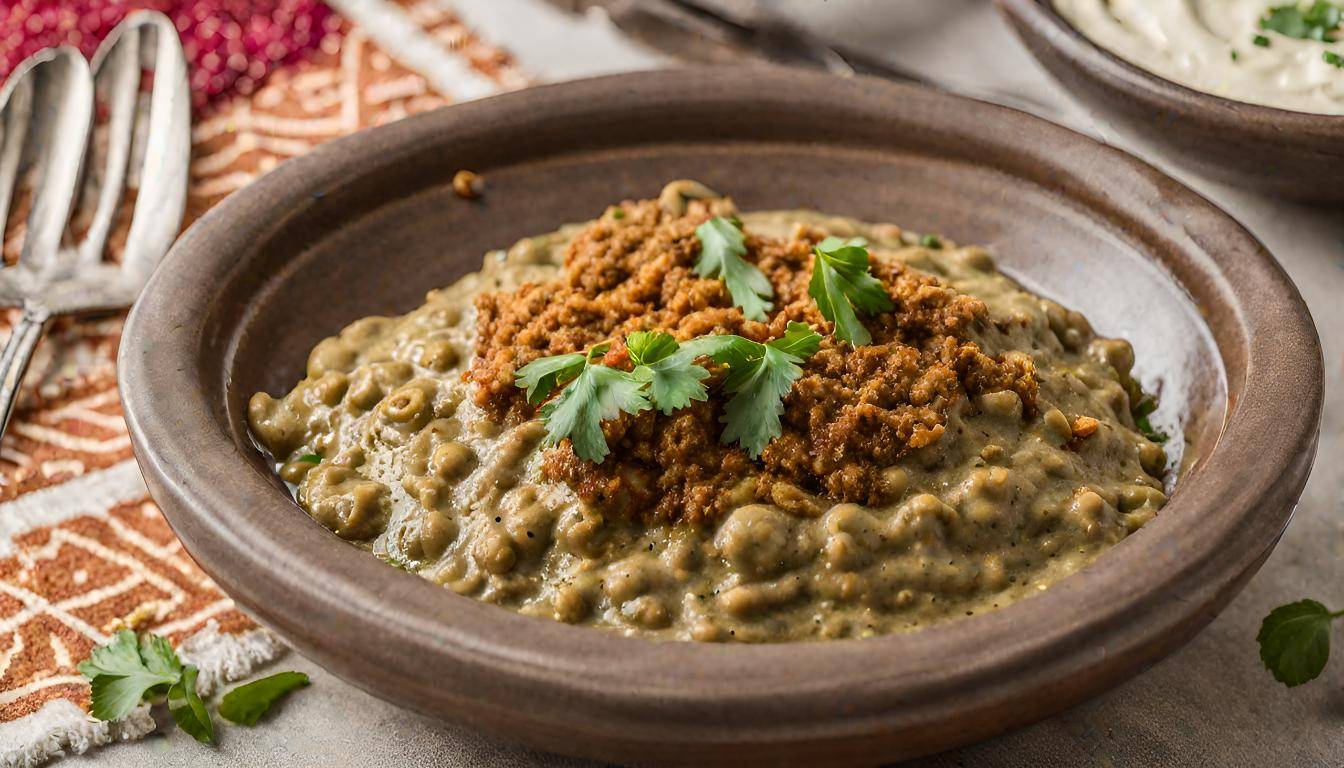Zaalouk with tahini, a traditional Moroccan salad or dip, is a delightful blend of roasted vegetables and exotic spices, topped with creamy tahini. This dish is not just a treat for the taste buds but also a healthy addition to any meal.
Introduction to Zaalouk with Tahini
Zaalouk, a staple in Moroccan cuisine, is typically made with eggplants, tomatoes, and a variety of spices. Adding tahini, a paste made from sesame seeds, introduces a nutty and creamy texture, making it a unique variant of the classic recipe. This dish is known for its versatility, often served as a dip, salad, or side.
- Origin: Zaalouk has its roots in Moroccan culinary traditions.
- Cultural Significance: It’s a symbol of the rich and diverse Moroccan food culture.
Ingredients and Directions
The beauty of zaalouk lies in its simplicity and the flexibility of its ingredients. For a detailed list of ingredients and possible substitutions, check out NYT Cooking’s Zaalouk With Tahini Recipe.
Ingredients:
For Zaalouk:
- 2 large eggplants
- 4 ripe tomatoes, chopped
- 3 cloves of garlic, minced
- 1/4 cup extra-virgin olive oil, plus more for drizzling
- 1 teaspoon ground cumin
- 1 teaspoon sweet paprika
- Salt and pepper, to taste
- 1/4 cup chopped fresh parsley
- 1/4 cup chopped fresh cilantro
For Tahini Sauce:
- 1/4 cup tahini
- 2 tablespoons fresh lemon juice
- 1 clove of garlic, minced
- 3 tablespoons water, or as needed
- Salt, to taste
Directions:
Preparing the Vegetables:
- Roast the Eggplants: Preheat your oven to 400°F (200°C). Pierce the eggplants with a fork and place them on a baking sheet. Roast in the oven for about 30-40 minutes, or until the skin is charred and the inside is soft. Allow them to cool, then peel and discard the skin. Chop the flesh roughly.
- Prepare the Tomatoes: While the eggplants are roasting, blanch the tomatoes in boiling water for a few minutes. Peel and chop them.
Making Zaalouk:
- Cook the Vegetables: In a large skillet, heat the olive oil over medium heat. Add the minced garlic and cook until fragrant. Add the chopped tomatoes, cumin, paprika, salt, and pepper. Cook for about 10 minutes, until the tomatoes are soft.
- Combine with Eggplant: Add the chopped eggplant to the skillet. Mash the mixture with a fork or potato masher until it reaches your desired consistency. Cook for another 10-15 minutes, stirring occasionally. If the mixture seems too dry, add a little water.
- Finish with Herbs: Stir in the chopped parsley and cilantro. Adjust the seasoning if necessary.
Preparing Tahini Sauce:
- Make the Tahini Sauce: In a small bowl, whisk together the tahini, lemon juice, minced garlic, and water. Add more water if needed to reach a pourable consistency. Season with salt.
Serving:
- Serve the Zaalouk: Transfer the Zaalouk to a serving dish. Drizzle with a bit more olive oil if desired. Serve warm or at room temperature.
- Add Tahini Sauce: Drizzle the tahini sauce over the Zaalouk just before serving.
Nutritional Value and Health Benefits
-
Nutritional Value:
- Low in Calories: Eggplants and tomatoes, the primary ingredients in Zaalouk, are low in calories, making this dish a good option for weight management.
- High in Fiber: Eggplants are a good source of dietary fiber, which is beneficial for digestive health.
- Rich in Vitamins and Minerals: Tomatoes are rich in vitamins C and K, potassium, and folate. Eggplants contain vitamins such as B1 and B6 and minerals like copper, magnesium, and manganese.
- Healthy Fats: The olive oil and tahini (sesame seed paste) in Zaalouk contribute healthy fats, particularly monounsaturated fats and omega-3 fatty acids, which are good for heart health.
Health Benefits:
- Heart Health: The healthy fats from olive oil and tahini can help in maintaining a healthy heart by reducing cholesterol levels and lowering the risk of heart disease.
- Digestive Health: The high fiber content in eggplants promotes gut health and regular bowel movements.
- Antioxidant Properties: Both eggplants and tomatoes contain antioxidants like vitamins C and E, and lycopene (in tomatoes), which combat oxidative stress and may reduce the risk of chronic diseases.
- Blood Sugar Control: The fiber in eggplants can help regulate blood sugar levels, making Zaalouk a suitable dish for people with diabetes.
- Bone Health: Vitamin K and calcium present in the ingredients are essential for maintaining bone health.
- Immune System Support: The vitamin C in tomatoes is vital for the immune system’s proper functioning.
Considerations:
- Sodium Content: Depending on how much salt is used in the recipe, Zaalouk can have varying levels of sodium. It’s advisable to limit salt intake, especially for those with high blood pressure.
- Allergies: Individuals with sesame allergies should be cautious due to the presence of tahini.
For more variations and creative cooking ideas, visit Mama’s Happy Kitchen – Zaalouk with Tahini.
Pairing with Other Dishes
Zaalouk pairs wonderfully with a range of dishes, enhancing the overall dining experience.
- Complementary Main Courses: Perfect with grilled fish or meat.
- Suggested Side Dishes: Complements couscous, rice, or a simple green salad.
Storing and Reheating Tips
Proper storage and reheating are crucial to maintaining the dish’s flavor and texture.
- Best Practices for Storage: Store in an airtight container in the refrigerator.
- Reheating without Losing Flavor: Gently reheat on the stove or in a microwave.
Tips for Enhancing Flavor
- Spice Variations: Experiment with different spices such as harissa or smoked paprika for a unique twist.
- Tahini Quality: Using high-quality tahini can significantly impact the flavor profile of Zaalouk.
Cultural Significance and Variations
- Regional Differences: Explore how Zaalouk is prepared in different regions of Morocco.
- Fusion Recipes: Discover how Zaalouk has been adapted to various cuisines around the world.
For those interested in exploring more about the fusion of different culinary traditions, the Buffalo Shrimp: A Culinary Journey article provides an exciting look at combining diverse flavors.
Pairing with Beverages
- Wine Pairings: Suggestions for wines that complement the flavors of Zaalouk.
- Non-Alcoholic Beverages: Ideas for refreshing drinks that go well with this dish.
Hosting and Entertaining
- Serving Ideas for Gatherings: How to present Zaalouk in a party setting.
- Pairing with Other Appetizers: Ideas for appetizers that complement Zaalouk for a well-rounded menu.
For those planning a gathering and looking for more appetizer ideas, the article on Cheesy Chicken Bacon Ranch Crescent Rolls: A Flavorful Delight offers great inspiration for delicious starters.

